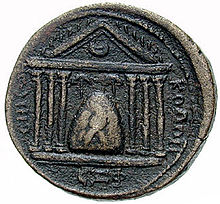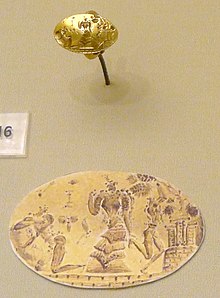Baetyl

A baetyl (also betyl), literally "house of God" is a sacred stone (sometimes believed to be a meteorite) or a pillar that was venerated and thought to house a God or deity.[1] The most famous example is the Omphalos stored in the Temple of Apollo at the Greek town of Delphi.[2]
The term baetyl was used in ancient near eastern sources, in the form of "beth-el", as well as in Greek and Roman sources, as a baitylos. In the former, the term was used to refer to the names of gods or places. Examples include Bethel, a location described in the Hebrew Bible, and the deity Bethel, who was mentioned in texts like Esarhaddon's Treaty with Ba'al of Tyre and the Elephantine papyri. In the latter, the word was used to describe a round stone that had fallen from the sky (i.e. a meteorite).[3]
The word baetyl has been vaguely used in ancient and modern sources[4][5] and there has been much debate among historians about how ancient and modern usage compare to each other and how precise and how accurately the usage of the original term maps onto what modern historians typically refer to as "baetyls".[6] Generally, it describes a stone that a god dwells in. Different traditions of baetyl can be distinguished further. One involves the black rounded stones thought to have fallen from heaven, potentially attested as early as the 3rd century BC by Sotakos of Karystos, though his work is lost, and the datum comes from a quotation in Pliny the Elder. A second involves the aniconic representation of a god using a standing stone (particular one of cultic function).[7]
Etymology
The term baetyl is a derivation of the Greek baitylos, itself being derived from the Semitic term bytʾl, or ("beth-el", "house of god") where it appears to have referred to open-air sanctuaries.[8][7]
In literature
Ancient Near East
The earliest known evidence for the baetyl concept in the ancient near east, where it designated either the name of a place or a god, comes from the 8th century BC, from three Aramaic stelae discovered at the site of Sfire. In the first half of the 7th century BC, a Phoenician-Aramaic god known as Bethel is first attested.[7]
In the Bible
The Book of Genesis records a story (28:10–22) concerning the patriarch Jacob. According to the story, Jacob went to sleep after laying his head on a certain rock. It was in this instance that he had the vision known as Jacob's Ladder, which included an appearance of God. When he awoke, Jacob declared that God was in the location he was in. He declared the place to be the "house of God" (and so named it Bethel) and took the stone that he was laying his head on and set it up as a sacred pillar.[9] Though this narrative has been appealed to in some discussions of baetyls, the term Bethel ("House of God") is not used to refer to the stone but to the new name of the town as a whole. Furthermore, the Hebrew word for "pillar", maṣṣebah, was translated into Greek in the Septuagint as oikos theou ("house of god"), and not baitylos, further indicates a lack of connection between this narrative and the baetyl concept. The stone itself is also not the actual location of God's presence, but is a memorial for the vision and vow of the story. Its sacred status is a result of its status as Jacob's pillar.[10]
Ancient Greece
The first Greek usage of the baitylos comes from a first century text, but only as the name of a slave, not a stone or a god. The next usage comes from the same century, in the Phoenician History by Philo of Byblos as the name of a god, one of the sons of Ouranos and Gaia. Philo then refers to a magical stone he calls a baitylia, invented by Ouranos (a common mythological etyiology for the origins of these sacred stones[7]). Philo's discussion is only extant in quotations from Eusebius who lived in the fourth century.[11] A third first-century reference is from Pliny the Elder, who describes the baitylos in the following manner[12]:
Sotacus distinguishes also two other varieties of the stone, a black and a red, resembling axe-heads. According to him, those among them that are black and round are supernatural objects; and he states that thanks to them cities and fleets are attached and overcome, their name being baetuli while the elongated stones are cerauniae.
A much later reference occurs in Damascius, a 6th century Neoplatonist, according to later quotations of his text by Photios I of Constantinople in his Bibliotheca. There, it acts as a prophetic stone discovered by a certain man named Eusebius who becomes its interpreter.[13]
Ancient Rome
It is only in the Later Roman Empire and in the period of late antiquity when the term baitylos came to take on connotations that combined its connotations of divinity from the Semitic tradition with the connotations of its function as an object in the Greek tradition. This fusion was a product of the dual influence of both Semitic and Greek tradition on the Roman Near East, particularly in northern Syria and Lebanon.[14]
In material sources
Ancient Near East

With various other sites around the Mediterranean, they were a feature of the Neolithic temple site of Tas-Silġ and other sites on Malta and Gozo.[15]
The Hittites had sacred stones known as huwasi installed into temples and open-air sanctuaries. Information about them comes from inventories from the time of the Hittite king Tudhalya IV.

In Minoan religion, it has been suggested that rubbing, lying, or sleeping on a baetyl could summon a vision of the god, an event which appears to be depicted on some gold Minoan seal rings, where the stones are large oval boulders.[16] A small serpentinite boulder was excavated very close to the Palaikastro Kouros, the only known Minoan cult image, destroyed around 1450 BC; perhaps it was its baetyl.[17]
In the Phoenician mythology related by Sanchuniathon, one of the sons of Uranus was named Bethel.[18] The worship of baetyls was widespread in the Phoenician colonies, including Tyre, Sidon, and Carthage, even after the adoption of Christianity, and was denounced by Augustine of Hippo.
A similar practice survives today with the Kaaba's Black Stone, which was sacred to the polytheists before Islam.[19]
Ancient Greece and Rome
In ancient Greek religion and mythology, the term was specially applied to the Omphalos of Delphi ("navel"),[2] the stone supposed to have been swallowed by Cronus (who feared misfortune from his own children) in mistake for his infant son Zeus, for whom it had been substituted by Gaea.[20] This stone was carefully preserved at Delphi, anointed with oil every day and on festive occasions covered with raw wool.[21]

In Rome, there was the stone effigy of Cybele, called Mater Idaea Deum, that had been ceremoniously brought from Pessinus in Asia Minor in 204 BC.[18] The emperor Elagabalus who reigned from 218 until 222 (and was probably a teenager for all his reign) came from Syria and was already the hereditary high priest of the cult of the god Elagabalus there. Once made emperor he brought the god's baetyl to Rome with great ceremony, and built the Elagabalium to house it. It seems to have been a conical meteorite.
In some cases an attempt was made to give a more regular form to the original shapeless stone: thus Apollo Agyieus was represented by a conical pillar with a pointed end, Zeus Meilichius in the form of a pyramid.
According to Tacitus, the simulacrum of the goddess at the temple of Aphrodite Paphia at her mythological birthplace at Paphos, on Cyprus, was a rounded object, approximately conical or shaped like a meta (a turning post on a Roman circus) but "the reason for this" he noted, "is obscure".[22]
Other famous baetylic idols were those in the temples of Zeus Casius at Seleucia Pieria, and of Zeus Teleios at Tegea. Even in the declining years of paganism, these idols still retained their significance, as is shown by the attacks upon them by ecclesiastical writers.[18]
See also
- Asherah pole, Canaanite sacred tree or pole honouring Asherah, consort of El
- Bema and bimah, elevated platform
- Bethel (god)
- Benben
- Black Stone, the venerated stone at Kaaba
- Ceremonial pole
- High place, raised place of worship
- List of Greek mythological figures
- Kami, central objects of worship for Shinto, some of which are natural phenomena and natural objects such as stones.
- Lingam, abstract representation of the Hindu deity Shiva
- Banalinga, stones naturally worn to ovoid shapes in river beds in India
- Matzevah
- Menhir
- Pole worship
- Shaligram, river-bed fossils in India, considered holy
- Stele, stone or wooden slab erected as a monument
- Turbah, small clay or earthen slabs used by Twelver Muslims
References
Citations
- ^ "Baetyl". Livius. Retrieved 2024-05-16.
- ^ a b Doniger 2000, p. 106.
- ^ Gaifman 2008, p. 44–46.
- ^ Pagolu 1998.
- ^ Marinatos 2010, p. 87.
- ^ Gaifman 2008, p. 42–44.
- ^ a b c d Wenning 2001, p. 80.
- ^ Gaifman 2008, p. 42.
- ^ Marinatos 2004.
- ^ Gaifman 2008, p. 47–51.
- ^ Gaifman 2008, p. 51–52.
- ^ Gaifman 2008, p. 53–54.
- ^ Gaifman 2008, p. 54.
- ^ Gaifman 2008, p. 55–57.
- ^ Vella, Horation C. R., in Archaeology and Fertility Cult in the Ancient Mediterranean, p. 315, 1986, Gruner, ISBN 9789027272539
- ^ Marinatos 2004, p. 32–39.
- ^ MacGillivray & Sackett 2000, p. 166.
- ^ a b c One or more of the preceding sentences incorporates text from a publication now in the public domain: Chisholm, Hugh, ed. (1911). "Baetylus". Encyclopædia Britannica. Vol. 3 (11th ed.). Cambridge University Press. pp. 191–192.
- ^ Ibn Ishaq (1964). The life of Muhammad. The Folio Society.
- ^ Chisholm 1911 cites Etymologicum Magnum, s.v.
- ^ Chisholm 1911 cites Pausanias X. 24.
- ^ Tacitus. Histories. Vol. 2. Translated by Moore, Clifford H. Cambridge, Massachusetts: Harvard University Press. pp. 164–165. ISBN 0-674-99039-0. OCLC 11108482.
Sources
- Doniger, Wendy (2000), Merriam-Webster's Encyclopedia of World Religions, Springfield, Mass.: Merriam-Webster, p. 106, ISBN 0-87779-044-2
- Gaifman, Milette (2008). "The Aniconic Image of the Roman Near East". In Kaizer, Ted (ed.). The Variety of Local Religious Life in the Near East in the Hellenistic and Roman Periods. Brill.
- MacGillivray, Alexander; Sackett, Hugh (2000). "The Palaikastro Kouros: the Cretan god as a young man". British School at Athens Studies. 6: 165–169.
- Marinatos, Nanno (2004). "The Character of Minoan Epiphanies". Illinois Classical Studies. 29: 25–42.
- Marinatos, Nanno (2010). Minoan Kingship and the Solar Goddess: A Near Eastern Koine. University of Illinois Press.
- Pagolu, Augustine (1998). "Sacred Pillars". The Religion of the Patriarchs. A&C Black. pp. 135–170.
- Palmer, Robert Everett Allen (1997), Rome and Carthage at Peace, Stuttgart: F. Steiner, p. 99, ISBN 3-515-07040-0
- Wenning, Robert (2001). "The Betyls of Petra". Bulletin of the American Schools of Oriental Research. 324 (1): 79–85.
Further reading
- "Baetyl" Jona Lendering, Livius.org
- Uta Kron: "Heilige Steine", in: Kotinos. Festschrift für Erika Simon, Mainz 1992, S. 56–70, ISBN 3-8053-1425-6
